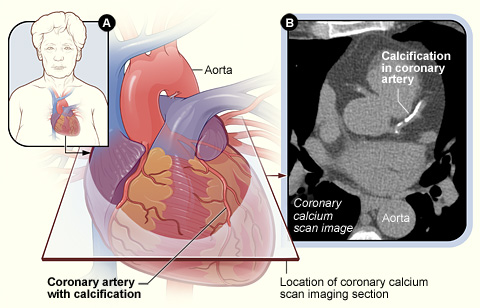What Is a Coronary Calcium Scan?
A coronary calcium scan is a test that looks for specks of calcium in the walls of the coronary (heart) arteries. These specks of calcium are called calcifications (KAL-sih-fih-KA-shuns).
Calcifications in the coronary arteries are an early sign of coronary heart disease (CHD). CHD is a disease in which a waxy substance called plaque (plak) builds up in the coronary arteries.
Over time, plaque can harden or rupture (break open). Hardened plaque narrows the coronary arteries and reduces the flow of oxygen-rich blood to the heart. This can cause chest pain or discomfort called angina (an-JI-nuh or AN-juh-nuh).
If the plaque ruptures, a blood clot can form on its surface. A large blood clot can mostly or completely block blood flow through a coronary artery. This is the most common cause of a heart attack. Over time, ruptured plaque also hardens and narrows the coronary arteries.
CHD also can lead to heart failure and arrhythmias (ah-RITH-me-ahs). Heart failure is a condition in which your heart can't pump enough blood to meet your body's needs. Arrhythmias are problems with the rate or rhythm of your heartbeat.
Overview
Two machines can show calcium in the coronary arteries—electron beam computed tomography (EBCT) and multidetector computed tomography (MDCT).
Both use x rays to create detailed pictures of your heart. Your doctor will study the pictures to see whether you're at risk for future heart problems.
A coronary calcium scan is a fairly simple test. You'll lie quietly in the scanner machine for about 10 minutes while it takes pictures of your heart. The pictures will show whether you have calcifications in your coronary arteries.
Coronary Calcium Scan

Figure A shows the position of the heart in the body and the location and angle of the coronary calcium scan image. Figure B is a coronary calcium scan image showing calcifications in a coronary artery.
Because calcifications are an early sign of CHD, a coronary calcium scan can show whether you're at risk for a heart attack or other heart problems before other signs and symptoms occur.
Outlook
A coronary calcium scan is most useful for people who are at moderate risk for heart attacks. You or your doctor can calculate your 10-year risk using the Risk Assessment Tool from the National Cholesterol Education Program.
People who are at moderate risk have a 10–20 percent chance of having a heart attack within the next 10 years. The coronary calcium scan may help doctors decide who within this group needs treatment.
Clinical trials are research studies that explore whether a medical strategy, treatment, or device is safe and effective for humans. To find clinical trials that are currently underway for Coronary Calcium Scan, visit www.clinicaltrials.gov.
The NHLBI updates Health Topics articles on a biennial cycle based on a thorough review of research findings and new literature. The articles also are updated as needed if important new research is published. The date on each Health Topics article reflects when the content was originally posted or last revised.















